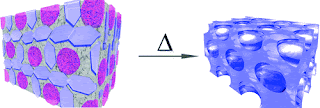They present a novel “brick and mortar” strategy for creating highly efficient transparent TiO2 coatings for photocatalytic and photovoltaic applications. Their approach is based on the fusion of preformed titania nanocrystalline “bricks” through surfactant-templated sol−gel titania “mortar”, which acts as a structure-directing matrix and as a chemical glue. The similar chemical composition of both bricks and mortar leads to a striking synergy in the interaction of crystalline and amorphous components, such that crystallization is enhanced upon thermal treatment and highly porous and highly crystalline structures are formed at very mild conditions. Coatings with a broad variety of periodic mesostructures and thicknesses ranging from few nanometers to several micrometers are accessible using the same organic template, and the final structures are tunable by varying the fraction of the “bricks”. The beneficial combination of crystallinity and porosity leads to greatly enhanced activity of the films in photocatalytic processes, such as the photooxidation of NO. Acting as the active layers in dye-sensitized solar cells, films of only 2.7 μm in thickness exhibit a conversion efficiency of 6.0%.
 Scheme 1. Formation of Crystalline Mesoporous Titania Films (right side) via the “Brick and Mortar” Approach; Nanocrystalline Titania “Bricks” (light blue, left side) are Dispersed in Amorphous Titania “Mortar” (grey), Which Is Periodically Self-Assembled around the Micelles of the Polymer Template (magenta).
Scheme 1. Formation of Crystalline Mesoporous Titania Films (right side) via the “Brick and Mortar” Approach; Nanocrystalline Titania “Bricks” (light blue, left side) are Dispersed in Amorphous Titania “Mortar” (grey), Which Is Periodically Self-Assembled around the Micelles of the Polymer Template (magenta).Full article available at:
http://pubs.acs.org/doi/full/10.1021/cm8029246


No hay comentarios.:
Publicar un comentario